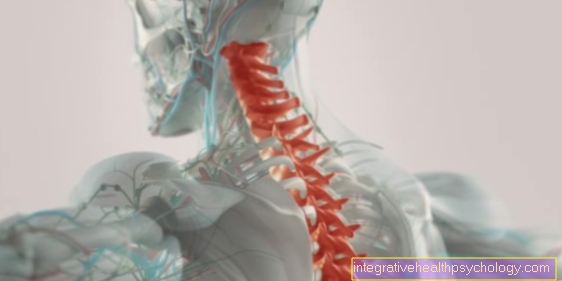Coma after a brain hemorrhage
General

Cerebral haemorrhage can occur for different reasons and in different locations within the skull. Cerebral haemorrhage is usually associated with typical symptoms, depending on the extent of the bleeding. Disturbances in consciousness such as a coma can occur, especially if the bleeding is profuse. People who are in a coma cannot be awakened even by repeated painful stimuli. The prognosis of a cerebral hemorrhage as a result of which the affected person develops a coma can be classified as relatively poor. As part of the treatment of the bleeding, it is important to be able to diagnose this as the cause of the coma. The therapy consists primarily of maintaining the vital functions of the body and the management of ideal intracranial pressure. In some cases, surgical intervention may be necessary.
You might also be interested in: Operation of a cerebral haemorrhage
Causes and symptoms
The symptoms that can occur with a cerebral hemorrhage are largely determined by the location and extent of the bleeding. In addition to a variety of typical symptoms, a loss of consciousness in the form of a coma is a typical symptom of severe and pronounced cerebral hemorrhage. In a coma after a cerebral haemorrhage, the person concerned cannot be awakened even by repeated pain stimuli. Furthermore, vital reflexes and functions fail during the unconscious state. For example, there is no longer a respiratory reflex, which is why comatose people usually need intensive medical care and ventilation to prevent serious consequences and death.
Read more on the topic: Cerebral hemorrhage symptoms
A cerebral hemorrhage can occur for many different reasons. In addition to head injuries, bleeding can also occur spontaneously. Risk factors for cerebral haemorrhage include high blood pressure, obesity, nicotine and alcohol consumption, and blood clotting disorders. If a cerebral artery aneurysm is present, there is a risk of rupture with subsequent massive cerebral hemorrhage.
Read more on this topic:
- What are the signs of a cerebral hemorrhage?
- Cerebral artery aneurysm
A coma is a symptomwhich can occur as a result of many diseases. If the coma occurs as part of a cerebral haemorrhage, it is because of a massive impairment of brain function.
The space inside the skull is generally very limited, which is why a cerebral hemorrhage always occurs with a Increase in pressure inside the skull goes hand in hand. If you bleed heavily Parts of the brain shifted to one side and compressed. With a massive increase in pressure, parts of the brain can become so irritated that the normal function of certain parts of the brain can no longer be maintained and a coma occurs.
therapy
The therapy one Cerebral hemorrhage, which with a coma goes along depends above all on one artificial maintenance of vital functions. It is one intensive medical care of the person concerned is necessary. A artificial respiration is also necessary, as the respiratory reflex in those affected usually fails as a result of the coma.
In order to keep the brain damage as low as possible and to restore the consciousness of those affected, a Reduction of intracranial pressure aimed at. To achieve such a reduction, a artificial lowering of blood pressure performed. There are also Medicationwhich can specifically lower the pressure inside the skull.
Invasive measures can help in individual cases to lower intracranial pressure. These interventions can be a manual evacuation of the blood as well as inserting a small tube (drainage) in the brain include.
Therapeutic measures that do not directly treat the cerebral haemorrhage, but which can prevent frequently occurring complications, should also be undertaken. This includes a Thrombosis prophylaxis as well as a close observation of blood values of those affected.
Tracheal incision
A Tracheal incision (Tracheotomy) is a measure which, when a artificial respiration over a long period of time is carried out. There are different procedures, which are summarized under the term of a tracheal incision. In the context of a cerebral haemorrhage that is associated with a coma, an incision is usually necessary because this is necessary for the Long-term ventilation is required.
The doctor pierces the anesthetized patient's windpipe from the outside with a needle and pushes a wire into it. Then the hole in the skin and the windpipe is expanded so that a plastic tube fits into it, through which the person concerned can be ventilated. During this measure, the person concerned is sedated and does not notice the procedure.
Illustration of the trachea

- Windpipe (approx. 20 cm) -
Trachea - Thyroid cartilage -
Cartilago thyroidea - Cricoid cartilage -
Cartilago cricoidea - Ring band -
Annular ligament - Tracheal cartilage -
Cartilago trachealis - Cover fabric - Tunica adventitia
- Trachea glands -
Glandulae tracheales - Mucous membrane - Tunica mucosa
- Membrane rear wall -
Pariesmembranaceus - Tracheal Muscle -
Tracheal muscle - Bronchiole - Bronchiolus
- Left lung -
Pulmo sinister - Left main bronchus -
Bronchus principalis sinister - Bifurcation of the windpipe -
Bifurcatio tracheae - Right main bronchus -
Bronchus principalis dexter - Right lung -
Pulmodexter
You can find an overview of all Dr-Gumpert images at: medical illustrations
consequences
The consequences of a cerebral haemorrhage associated with a coma can be very different. In the best case, those affected do not suffer any consequences of the disease. In many more cases, however, severe cerebral hemorrhage is associated with permanent brain dysfunction. These can affect any task area of the brain. Paralysis and disorders of speech production, speech understanding, sight, hearing or problems swallowing are particularly common. A cerebral haemorrhage associated with a coma also often leads to death. This occurs either as a result of excessive damage to the brain or due to complications. Typical complications are diseases such as pneumonia or blood poisoning (sepsis).
Read more on the topic: What are the consequences of a cerebral hemorrhage
lung infection
A lung infection is a disease that occurs in people who have a Cerebral hemorrhage are affected relatively often. Especially patients who, due to the Comas artificially ventilated are at risk for pneumonia to occur. So it happens again and again that bacteria get into the lungs via ventilation and cause inflammation there. It is about a very serious complicationwhich for Death of the person concerned. The prognosis of the disease depends on which pathogen is responsible for the pneumonia and how the individual condition of the person affected.
death
At a Cerebral hemorrhage, which with a coma goes hand in hand, it is a very serious illness, which often can also end in death. This can occur on the one hand due to damage to the brain (brain death) or due to complications that arise.
Brain death describes a state in which all Irreversible brain functions damaged were. The damage to the cells of the Brain goes with death. The diagnosis of brain death is very extensive. So this must independently determined by two doctors become.
Complications can also occur during the coma, which can also result in death. Pneumonia and blood poisoning in particular (sepsis) can have this serious consequence.
forecast

Read more on the topic: What are the chances of recovery after a cerebral hemorrhage?
The individual prognosis of a cerebral hemorrhage with an accompanying coma depends on various factors. Overall, however, the prognosis for the disease is poor. The symptom of the coma can be classified as a poor prognostic factor for a cerebral hemorrhage.
However, the individual prognosis is influenced by other factors. In particular, the cause of the bleeding and the age of the patient play an important role in assessing the prognosis in each individual case.
Duration of coma after a cerebral haemorrhage
The Duration one Comaswhich on a Cerebral hemorrhage can only be attributed very difficult to estimate become. This is largely determined by the Extent and location of the bleeding influenced. The duration of the coma can vary depending on how badly the cells in the brain have been damaged.
However, it is often impossible to predict how long the coma will last, even if the extent and location of the bleeding are known. A wait-and-see behavior and intensive therapy can help reduce the individual duration of the coma. However, waking up from a coma cannot be expected in all cases. The annoy in the brain can be so badly damaged by the bleeding and the consequences of it that with a Waking up is no longer expected. At a total loss of activity in the brain can often only the brain death to be established.
Waking up after the coma
The goal of therapy in a Cerebral hemorrhage with accompanying coma is the uncomplicated healing of the bleeding in the brain and with it the regaining of consciousness. However, the therapeutic goal is not always achieved. So do patients. who suffer from a cerebral haemorrhage and develop a coma over time, a relatively poor prognosis to wake up. Those affected wake up when the Pressure inside the brain and skull decreases and the Functionality of the crucial brain areas not damaged too much has been. Special diagnostic methods can provide clues as to how likely it is for someone to wake up from a coma. By the Stopping certain medications the regaining of consciousness can be provoked in these cases.
Chances of survival
The chances of survival of a person who suffers from a cerebral hemorrhage and develops a coma can be very different. This mainly depends on the extent to which the bleeding or pressure in the skull is damaging the cells of the brain. Severe damage and high pressure can lead to a total loss of function of the brain and thus to brain death.
There are some studies that investigate the chances of survival of a cerebral hemorrhage with an associated coma. However, the results of the studies differ considerably in some cases. The mortality rate, i.e. the proportion of patients with a cerebral haemorrhage who will die over time, regardless of whether a coma occurs or not, is about 25-50%. It can be assumed that a coma significantly worsens this rate. One study came to the result that 91% of the patients who suffered a coma as part of a cerebral haemorrhage died in the course. Another study estimated the rate to be well over 80%.
Overall, the chances of surviving a cerebral hemorrhage if it is accompanied by a coma are therefore relatively poor. However, the individual chance of surviving the event can be influenced by various factors that were not included in the studies. The cause of the bleeding, previous illnesses and the age of the person affected also have an influence on the chances of survival.
More on this topic under: What are the chances of survival with a cerebral haemorrhage
Summary
In summary one is Cerebral hemorrhage with accompanying coma as very serious illness to classify. The coma recruits Symptom of the disease dar and is a important prognostic factor of the clinical picture. When a coma occurs, it usually represents a Damage to cells within the brain This can be both temporarily as well as definitely be.
So a coma can only last for a short period of time and last for a long time and even for death to lead. Important therapeutic agents in the treatment of the cerebral hemorrhage associated with coma are Maintaining vital functions through artificial ventilation and the Supply of liquid as well as one Control of pressure within the brain. In individual cases Operations help control bleeding in the brain.





























